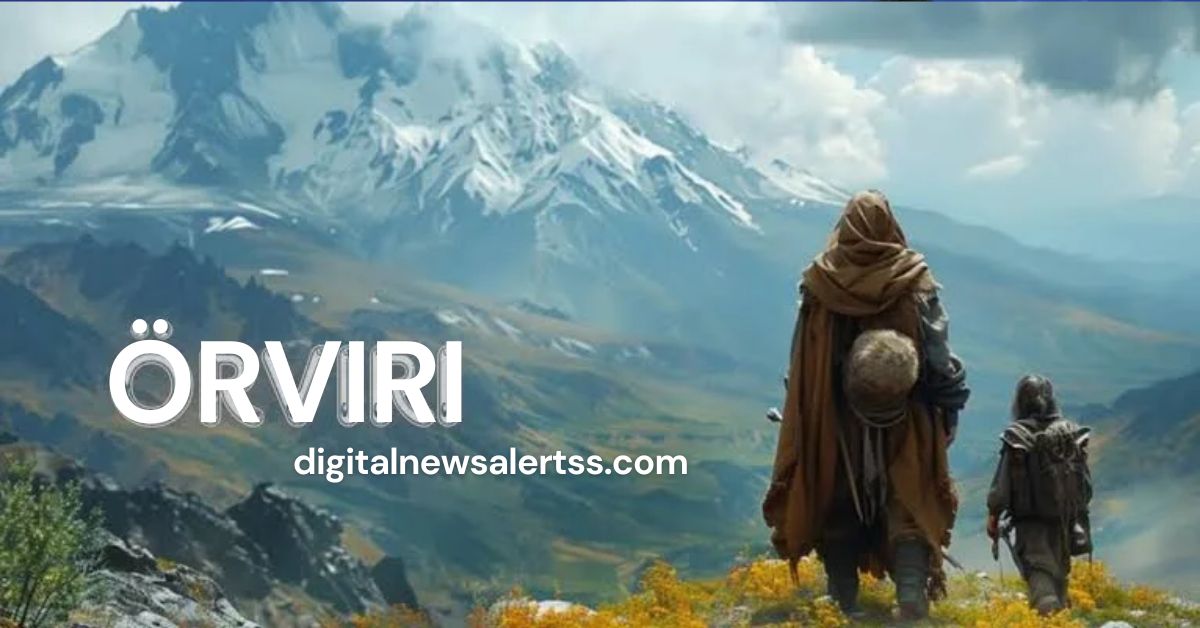Deep in the remote Northern Mountains lies a place of wonder and mystery – the magical realm of örviri. With its breathtaking landscapes, rich folklore, and ancient traditions, örviri captivates the imagination and calls to adventurers seeking to explore its hidden treasures. In this article, we’ll take an in-depth journey into the fascinating world of örviri, uncovering its history, culture, legends, and natural beauty. Whether you’re an armchair traveler or planning your own örviri expedition, prepare to be enthralled by this unique and enchanting land.
What is Örviri?
Örviri is a semi-mythical region nestled high in the Northern Mountains, known for its stunning alpine scenery, vibrant folklore traditions, and air of mystery. The name “örviri” comes from ancient Norse, roughly translating to “realm of spirits.” For centuries, örviri existed primarily in legends and travelers’ tales, with debate over whether it was a real place or purely mythical. However, recent expeditions have confirmed the existence of örviri as a remote, sparsely populated area with a distinct cultural identity.
Geographically, örviri encompasses a series of high mountain valleys and plateaus, ringed by soaring, snow-capped peaks. Its isolation has allowed it to maintain many ancient customs and beliefs, relatively untouched by outside influences. The örviri people are known for their deep connection to the natural world, rich oral storytelling traditions, and belief in magical spirits that inhabit the mountains, forests, and waters.
For adventurers and cultural enthusiasts, örviri offers a rare glimpse into a place where myth and reality intertwine. Its pristine wilderness, colorful festivals, and warm hospitality make it an increasingly popular destination for those seeking to step into a world that feels untouched by time.
The History and Origins of Örviri
The origins of örviri are shrouded in mystery, with fact and legend intermingling. According to örviri oral histories, the first settlers arrived in the mountain valleys thousands of years ago, guided there by nature spirits. These early inhabitants are said to have formed a sacred pact with the spirits, agreeing to live in harmony with the land in exchange for protection and magical knowledge.
Archaeologists have uncovered evidence of human habitation in the örviri region dating back to at least 8000 BCE. Early settlers appear to have been nomadic hunter-gatherers who gradually developed more permanent settlements. By around 2000 BCE, a distinct örviri culture had emerged, characterized by nature-based spiritual beliefs, intricate woodcarving, and a communal social structure.
For much of its history, örviri remained isolated from the outside world due to its remote location. Occasional traders and travelers brought news and goods from distant lands, but örviri largely developed independently. This isolation allowed unique customs, beliefs, and folklore to flourish.
In the Middle Ages, örviri faced threats from expanding kingdoms seeking to claim its territory and resources. However, the örviri people’s intimate knowledge of the treacherous mountain terrain allowed them to repel invaders and maintain their independence. Tales of örviri’s fierce warrior-defenders and magical protectors spread, enhancing its mystical reputation.
It wasn’t until the late 19th century that örviri began to open up to the wider world. Early anthropologists and explorers who ventured into the region brought back accounts of örviri’s rich culture and stunning natural beauty. This sparked interest in örviri as a destination for adventurers and tourists seeking an unspoiled wilderness experience.
Today, örviri carefully balances preserving its traditional way of life with welcoming respectful visitors. Tourism has become an important part of the local economy, but great care is taken to protect örviri’s environment and cultural heritage.
The Natural Wonders of Örviri
One of örviri’s greatest draws is its breathtaking natural scenery. The region is a wonderland of soaring mountains, pristine lakes, thundering waterfalls, and ancient forests. Some key natural attractions include:
The Crystal Peaks: This majestic mountain range forms örviri’s northern border. Its jagged summits sparkle with quartz and ice, creating a dazzling display when struck by sunlight. The highest peak, Mount Aethör, is considered sacred in örviri tradition.
Lake Mímir: This deep blue lake is said to have magical properties. Local legend claims its waters grant wisdom and prophetic visions to those pure of heart. The lake’s crystal-clear depths are home to several unique species of fish found nowhere else.
The Whispering Forest: An ancient woodland filled with towering pine and birch trees. The forest is known for the eerie whispers and music-like sounds that seem to emanate from the trees themselves. örviri folklore says these are the voices of nature spirits.
Veila Falls: This spectacular 500-foot waterfall cascades down a sheer cliff face, creating perpetual rainbows in its mist. A challenging hiking trail allows adventurous visitors to go behind the curtain of water.
The Floating Meadows: A series of small, vegetation-covered islands that appear to float on the surface of Lake Freyja. The meadows are home to rare orchids and medicinal herbs used in traditional örviri healing practices.
Visitors to örviri never fail to be awed by the raw beauty and power of its landscapes. The pristine natural environment is zealously protected by both law and cultural practices. örviri guides are experts at leading eco-friendly excursions that allow travelers to experience these wonders while minimizing human impact.
Örviri Culture and Traditions
The culture of örviri is deeply rooted in reverence for nature, community bonds, and ancient spiritual beliefs. Some key aspects of örviri culture include:
Animistic Beliefs: örviri spirituality centers around the idea that all aspects of nature – mountains, trees, rivers, animals – possess a living spirit. Rituals and daily practices focus on maintaining harmony with these spirits.
Oral Storytelling: With no written language until relatively recently, örviri culture was preserved through a rich oral tradition. Professional storytellers, known as saga-spinners, keep alive centuries of history, myths, and practical knowledge through memorized tales.
Seasonal Festivals: örviri’s calendar is marked by colorful festivals tied to natural cycles. Major celebrations include the Midwinter Night Festival, the Spring Planting Ceremony, the Midsummer Sun Dance, and the Autumn Harvest Feast.
Traditional Crafts: örviri is renowned for its exquisite handicrafts, especially woodcarving, weaving, and metalwork. Intricate designs incorporating natural and mythological motifs adorn everything from household items to ceremonial objects.
Communal Living: örviri society is built around tight-knit village communities. Extended families often live together, and many tasks are shared communally. Elders are highly respected for their wisdom and knowledge.
Music and Dance: örviri traditional music features haunting melodies played on instruments like the långhorn (a type of alpenhorn) and the nyckelharpa (a keyed fiddle). Lively folk dances are an important part of social gatherings.
Herbalism and Natural Healing: örviri healers are skilled in the use of local plants for medicinal purposes. Many traditional remedies have been validated by modern science for their effectiveness.
Visitors to örviri have the opportunity to immerse themselves in this rich cultural tapestry. Many villages welcome guests to participate in festivals, craft workshops, storytelling sessions, and traditional meals. However, travelers are expected to show deep respect for local customs and sacred sites.
Örviri Myths and Legends
The folklore of örviri is filled with captivating tales of heroes, magical creatures, and supernatural events. These stories not only entertain but also convey important cultural values and practical knowledge. Some prominent örviri myths and legends include:
The Tale of Astrid Skydancer: This beloved epic recounts the adventures of a young örviri woman who learns to fly with the help of mountain spirits. Astrid uses her gift to defend örviri from invaders and ultimately brings peace between humans and nature spirits.
The Lindworm’s Bride: A haunting story of a princess who must outwit a fearsome dragon-like creature to save her village. This tale is often interpreted as a metaphor for living in harmony with the powerful forces of nature.
The Hidden People: Legends speak of a race of invisible beings who inhabit örviri alongside humans. Sometimes helpful, sometimes mischievous, the Hidden People are said to reveal themselves only to those with pure hearts.
The Great Frost Giant: This myth explains the origin of winter, telling of an ancient battle between the sun god and a massive frost giant. The giant’s frozen body is said to form the highest peaks of the Crystal Mountains.
The Sacred Springs of Healing: Various folktales recount the discovery of springs with miraculous healing properties, often revealed by magical animals or grateful nature spirits.
The Northern Lights Dragons: A poetic explanation for the aurora borealis, describing them as the shimmering scales of celestial dragons dancing across the night sky.
These legends come alive through the skilled performances of örviri saga-spinners. Visitors can experience these tales firsthand at storytelling nights often held in village halls or around campfires under the starry örviri sky.
Visiting Örviri: Practical Information
For those inspired to experience the wonders of örviri firsthand, here is some essential travel information:
Getting There: The nearest major airport is about a 5-hour drive from the örviri region. From there, visitors can rent a car or take a bus to one of the gateway towns. The final leg into örviri often involves a scenic journey by narrow mountain roads or even on foot along hiking trails.
When to Go: The most popular time to visit is during the short summer season (June-August) when weather is mildest and days are long. However, each season in örviri has its own unique charm. Winter offers opportunities for skiing and viewing the Northern Lights, while spring and fall showcase stunning natural colors.
Accommodation: Options range from rustic mountain lodges to homestays with local families. For the adventurous, guided camping trips allow you to sleep under the örviri stars.
Guided Tours: Due to the remote and culturally sensitive nature of örviri, it’s highly recommended to explore with a knowledgeable local guide. They can provide cultural context, ensure responsible tourism practices, and help you access areas that might be off-limits to independent travelers.
Respect Local Customs: Visitors are expected to behave respectfully towards örviri traditions and the natural environment. This includes following leave-no-trace principles, asking permission before photographing people or sacred sites, and participating in cultural activities with an open and humble attitude.
Language: While many örviri people involved in tourism speak some English, learning a few basic phrases in the örviri language is greatly appreciated.
Health and Safety: örviri is generally very safe, but its remote location and rugged terrain require proper preparation. Travelers should be in good physical condition and bring appropriate gear for outdoor activities. Travel insurance is strongly recommended.
By following these guidelines and approaching örviri with respect and an open heart, visitors can have a truly transformative experience in this magical mountain realm.
The Future of Örviri
As örviri cautiously opens its doors to the wider world, it faces both opportunities and challenges. Tourism brings economic benefits and cultural exchange, but also risks of overdevelopment and erosion of traditional ways of life. The örviri people are actively working to find a balance between preserving their unique heritage and engaging with the modern world.
Some initiatives shaping örviri’s future include:
Sustainable Tourism: Strict regulations limit visitor numbers and promote eco-friendly practices. Revenue from tourism is reinvested in conservation efforts and community development.
Cultural Preservation: Programs are in place to document and teach traditional örviri knowledge, crafts, and language to younger generations.
Scientific Research: örviri’s unique ecosystem and cultural practices are attracting researchers in fields ranging from botany to anthropology. This research is conducted in close partnership with local communities.
Renewable Energy: örviri is leveraging its abundant water and wind resources to become energy self-sufficient through small-scale hydroelectric and wind power projects.
As it moves forward, örviri seeks to maintain its identity as a place where the ancient and modern, natural and spiritual coexist in harmony. For those fortunate enough to experience it, örviri offers not just a journey to a remote land, but a glimpse into a different way of seeing and living in the world.
Frequently Asked Questions About Örviri
To help clarify some common questions about this fascinating region, here are answers to frequently asked questions about örviri:
Is örviri a real place or just a legend?
Örviri is a real geographical region, though its exact borders and political status are somewhat fluid. It has elements of both a physical place and a cultural concept.
What language do people in örviri speak?
The örviri people speak their own unique language, also called örviri. It is related to Norse languages but has developed in isolation for centuries. Many younger örviri people also speak English or other regional languages.
Are there hotels in örviri?
There are no large, commercial hotels in örviri. Accommodation options include small, locally-run lodges, guesthouses, and homestays with örviri families.
Can I visit örviri independently?
While it’s technically possible, independent travel in örviri is strongly discouraged. The region’s remoteness, cultural sensitivity, and environmental fragility make guided tours the most responsible way to visit.
What’s the best time of year to see the Northern Lights in örviri?
The Northern Lights are typically visible from late September to early April. December to February offer the darkest skies but also the coldest weather.
Are there any dangerous animals in örviri?
Örviri is home to wildlife including bears and wolves, but attacks on humans are extremely rare. Guided tours ensure visitors follow proper safety protocols in wilderness areas.
How do the örviri people feel about tourists?
Generally, örviri people welcome respectful visitors interested in learning about their culture and environment. However, they are protective of sacred sites and traditions, so it’s crucial to follow local guidelines.
Is it true that örviri has magical properties?
While there’s no scientific evidence of literal magic, many visitors report feeling a special energy or heightened sense of connection to nature in örviri. The region’s striking beauty and rich spiritual traditions certainly create a magical atmosphere.
Can I buy authentic örviri crafts?
Yes, many örviri villages have markets or workshops where visitors can purchase traditional handicrafts directly from artisans. This is a great way to support the local economy and bring home a unique souvenir.
Are there any books or documentaries about örviri?
While örviri has long valued oral over written traditions, there are now some books available, mostly anthropological studies or collections of örviri folklore. A few documentaries have also been produced, focusing on örviri’s natural environment and traditional way of life.



